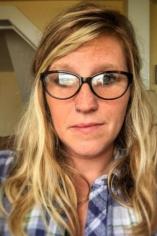91˛Öżâ education major Klair Heestand said the time she spent teaching refugee students in Akron in the spring was excellent preparation for when she enters her own classroom one day.
“It was very helpful because we’re going to have students of varying abilities, and students for whom English is a second language, no matter where we teach,” Heestand said. “We don’t need anyone left behind because of a language barrier.”
Heestand was one of a group of 91˛Öżâ students studying to be middle school teachers who spent the spring semester developing a program of integrated learning to teach refugee children in Akron’s North Hill neighborhood.
The semester-long project was part of the course “Curriculum and Organization” for advanced study middle school education majors, taught by Assistant Professor Amy Walker, Ph.D., in the School of Teaching, Learning and Curriculum Studies within the College of Education, Health and Human Services.

Walker partnered with the , an agency that serves immigrant and refugee populations in the Akron, Ohio, area to create a course that offered community learning and exploration for her students. One of the core principles of integrated learning is making sure the curriculum is authentic to the community, she said.
“Research shows that urban refugee students have a hard time integrating into their school communities. They don’t feel a sense of belonging in the community. Research recommends out-of-classroom learning experiences for them. This project answers that call and this project is built on culturally responsive teaching practices.” Walker said.
The group of 21 students spent most of the semester designing the learning programs that would be presented to the youngsters. “It was a completely student-run program,” Walker said.
The course culminated in the 91˛Öżâ students offering a three-day workshop at the North Hill Branch of the Akron-Summit County Public Library, which included a series of learning stations for the children to visit and engage in hands-on activities.

Heestand, a junior from Tallmadge, Ohio, said the topic of food was selected for the project, to improve students’ food literacy.
“Food is something that connects all of us,” she said. “But it’s very different in different parts of the world.”
Walker said Jamal Ferrasta, education director for the International Institute, had shared that immigrants often have difficulty understanding American foods and food systems.
Activities at the learning stations offered teaching on food, nutrition and food production, and meshed various learning areas including math, social studies, science, art and language arts. The topic of food worked well because food is such a large part of all cultures and creates a touchstone to which young children can easily relate.
One station offered recipes and gave the kids a chance to create their own bags of trail mix. At another station, students were given seeds for vegetables to plant in small paper cups, and at the same time given instruction on photosynthesis and how plants use sunlight to transform water and carbon dioxide into the nutrition the plant needs to grow.
Other lessons included water systems and plant pollination. Information was offered on where food comes from, understanding food allergies and where to find healthy foods such as fresh fruits and vegetables, Walker said.

To overcome any possible language barriers, Heestand said each learning station also incorporated visual communication so that everyone could participate. The children, she said, were active participants and most took part in more than one learning station.
“As future educators, it is an important lesson for us to learn in life – it’s a great thing to get out into the community,” Heestand said. “A lot of our classmates had never been to Akron, some were scared, they had never been to inner-city areas like this in their life. I think colleges should all participate in this. They should see the communities around them.”
The spring semester was the last semester of advanced study for much of the cohort, most of whom were finishing their junior year. “Most will be doing their student teaching in the fall or next spring,” Walker said.
Over the three days in April, 41 youngsters participated in the program, which was specifically timed to coincide with the Akron school’s spring break. Not all the students were from refugee/immigrant populations; some students were from the North Hill neighborhood.

While the programming was planned with refugee students in mind, it was culturally responsive and easily opened to the larger North Hill community, she said.
“I have to say I was super proud and super impressed, and so was the library and so was the non-profit International Institute,” Walker said. “It was really cool; the students did quality work.”
Walker said the project also helps with her own research, which investigates “how the university students’ planning with refugees impacts what their perception is of what equity looks like in the classroom.”
The spring project led to Walker obtaining a small grant to help pay for a similar five-day program over the summer that will be hosted at the International Institute’s education center in Akron. Seven of Walker’s students already have signed up to participate even though their class is over, she said.
“It’s here to stay, and we expect to offer it next spring and summer as well,” Walker said.
Their work also is expanding into the larger Akron community, she said, with ACME Fresh Markets contacting Walker about possibly offering some of the programming in their grocery stores.

